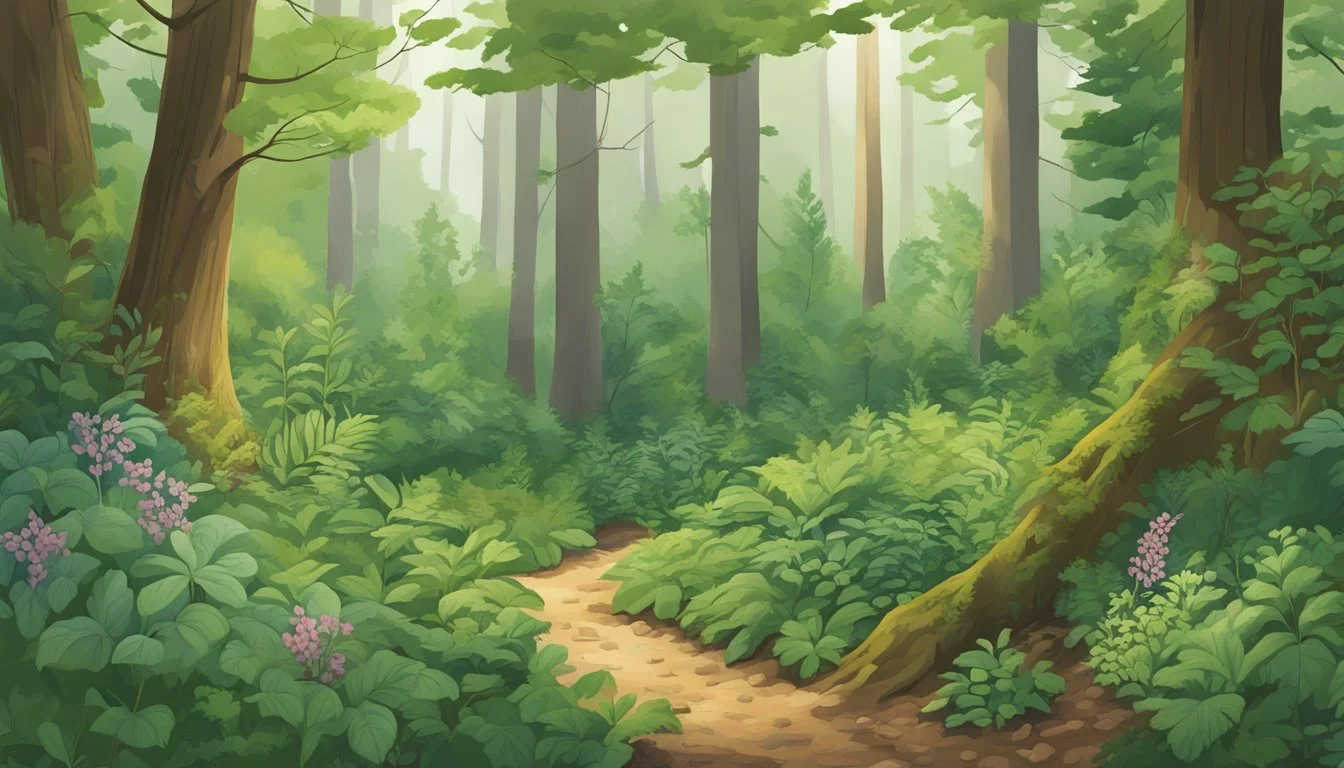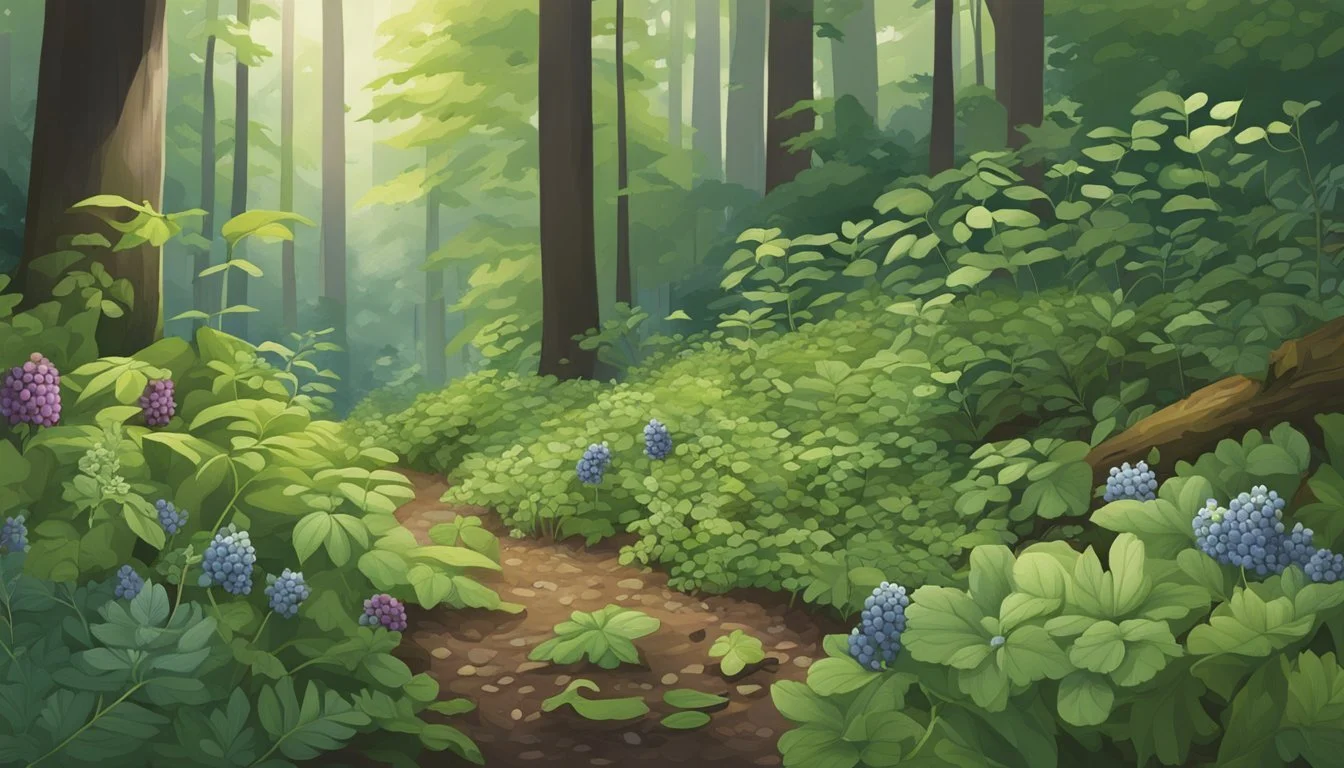Native Edible Plants in West Virginia
A Guide to Foraging and Identification
This Article is Part of Foraging Guide for All 50 US States
West Virginia's diverse ecosystems are home to a variety of native edible plants that have nourished inhabitants of the region for centuries. The rich woodlands, wetlands, and meadows provide favorable conditions for these plants to thrive. Understanding and identifying edible plants is not only important for foraging purposes but also plays a crucial role in the preservation of local heritage and biodiversity.
From the sweet tang of wild berries to the earthy taste of foraged greens, West Virginia's flora offers a plethora of flavors and nutrients. Among these, ramps—a wild onion species with a strong garlic flavor—are particularly esteemed and mark the arrival of spring in the Appalachian food tradition. Berries like blackberries (how long do blackberries last?), blueberries, and pawpaws are not only consumed fresh but also used in traditional recipes to create jams and desserts.
Beyond their culinary uses, many of these native plants are steeped in medicinal lore and have been used by local herbalists for their healing properties. As interest in sustainable living and natural food sources grows, the knowledge of how to safely harvest and consume these plants is increasingly valuable. Responsible foraging ensures the sustainability of these species for future generations to appreciate and rely on.
Interested in Mushroom Hunting in West Virginia?
West Virginia's lush forests and mountains make it an excellent location for mushroom hunting. The state boasts a diverse array of edible mushrooms, including morels, chanterelles, black trumpets, and lion's mane. The best time to hunt for mushrooms in West Virginia is typically from April to October, depending on the species and elevation. The Monongahela National Forest and other state parks offer prime spots for foraging. As with any mushroom hunting adventure, proper identification skills and respect for the environment and private property are essential for a safe and enjoyable experience in West Virginia's beautiful wilderness.
👉 Guide on Mushroom Hunting in West Virginia
Historical Context of West Virginia's Flora
The vegetation of West Virginia has been shaped by both historical events and ecological processes. European settlement significantly altered the landscape, introducing new species while relying on and affecting native plants.
European Settlement and Native Species
When Europeans arrived in what is now West Virginia, they encountered a rich diversity of plant life. They began altering the landscape, clearing land for agriculture and settlements. Native species such as the pawpaw (Asimina triloba), ramps (Allium tricoccum), and the American chestnut (Castanea dentata) were integral to both the diet and the environment of indigenous populations and European settlers.
Key Native Species:
Pawpaw: Used for food and medicine.
Ramps: Consumed as a food source.
American Chestnut: Provided timber and nuts (how long do nuts last?).
European settlers also introduced new agricultural practices and non-native species, intentionally and unintentionally, which led to competition with and displacement of some native flora.
Invasive vs. Native Species
The distinction between invasive and native species in West Virginia reflects the impact of human activity on the environment. Invasive species are those introduced, often by European settlers, that have propagated widely, often at the expense of native species.
Introduced Species Becoming Invasive:
Autumn Olive (Elaeagnus umbellata): Competes with native plants.
Multiflora Rose (Rosa multiflora): Crowds out native species.
Since their introduction, these invasive species have altered the local ecosystems, impacting the growth and proliferation of native edible plants. Efforts are in place to manage invasive species and to protect and promote West Virginia's native flora.
Understanding the West Virginia Environment
West Virginia's environment, characterized by diverse ecosystems and shaped by the region's topography and climate, influences the variety of native edible plants found throughout the state.
Ecosystems and Biodiversity
West Virginia hosts several ecosystems, from the Appalachian-Blue Ridge forests to the Central Appalachian Pine-Oak forests. This state displays a rich biodiversity, with ecosystems comprising deciduous forests, evergreens, and mixed woodlands. The variety of plants in these ecosystems is attributable to the range of elevation, from 240 feet in the Potomac River Valley to over 4,800 feet at Spruce Knob. The state's diverse flora includes tree species such as oak, hickory, maple, and more, which support an array of edible plants and fungi.
Key Ecosystem Components:
Forests: Deciduous, Evergreen, Mixed
Elevation Range: 240 - 4,800 feet
Key Flora: Oak, hickory, maple
Topography and Climate Impact on Flora
The state's topography directly influences its climate, which varies from humid continental in the mountainous regions to a humid subtropical climate in the lower areas. Temperature and precipitation variations create distinct growing conditions that shape the types of flora that can thrive. For instance, the higher elevations with cooler temperatures are conducive to plants such as ramps (wild leeks) and morels, while the warmer and more humid lowlands support species like pawpaws and black walnuts (how long do walnuts last?).
Climate Factors:
Temperature Variance: Cooler in the mountains, warmer in the lowlands
Precipitation: Affects soil moisture and plant growth
In conclusion, a comprehensive understanding of West Virginia's ecosystems and the impact of its topography and climate on the state's biodiversity is essential to appreciating the variety and abundance of native edible plants it sustains.
Types of Native Edible Plants
West Virginia's landscape is rich with a diverse array of plants that are both native and edible. The state is home to a variety of trees, shrubs, herbaceous plants, and fungi, offering a bounty of fruits (What wine goes well with fruits?), nuts, and leafy greens.
Trees and Shrubs Bearing Fruits and Nuts
Trees and shrubs in West Virginia provide a variety of fruits and nuts, essential for both wildlife and human consumption. Serviceberry (Amelanchier arborea) and Pawpaw (Asimina triloba) are notable fruit-bearing trees that are native to the region. The American Hazelnut (Corylus americana) and Black Walnut (Juglans nigra) yield nutritious nuts that can be harvested in the fall.
Fruit-Bearing Trees:
Serviceberry
Pawpaw
Nut-Bearing Trees:
American Hazelnut
Black Walnut
Herbaceous Plants and Leafy Greens
Herbaceous plants that offer edible leaves and stems thrive in West Virginia's forests and fields. Varieties such as Ramps (Allium tricoccum) are a popular wild onion with a strong garlic flavor, highly favored in local cuisine. Wood Sorrel (Oxalis spp.), with its tart, lemon-flavored leaves, is often used as a culinary herb.
Edible Herbaceous Plants:
Ramps
Wood Sorrel
Fungi Varieties and Their Uses
Fungi are a crucial part of West Virginia's ecosystem, with several varieties that are both edible and sought after. Morels (Morchella spp.), recognized for their unique honeycombed appearance, are highly prized by foragers. Chanterelles (Cantharellus spp.), with their distinctive golden color, offer a subtle apricot-like flavor. Hen of the Woods (Grifola frondosa) and Chicken of the Woods (Laetiporus sulphureus) are other notable edible fungi, each with a distinct taste and texture suited to different culinary uses.
Edible Fungi Varieties:
Morels
Chanterelles
Hen of the Woods
Chicken of the Woods
Identification and Foraging
In the forests and fields of West Virginia, foragers can find a bounty of native edible plants. Knowing how to correctly identify these plants and responsibly gather them is crucial for both personal safety and ecological health.
Safe Identification of Edible Plants
Accurate identification is the first and most important step in foraging for food. Misidentification can lead to the ingestion of toxic plants, posing serious health risks. Foragers should equip themselves with reliable field guides specific to the West Virginia region and consider using digital applications with image recognition capabilities to double-check their finds. In-person workshops or foraging tours led by experienced foragers can also provide valuable hands-on learning.
For trustworthy identification, examine the following plant characteristics:
Leaf shape and pattern: Note the arrangement of leaves on the stem and their overall shape.
Flowers and fruit: Study the color, size, and time of year they appear.
Stem and root: Look at the color, texture, and whether the stem is woody or fleshy.
Habitat: Consider the environment where the plant grows, such as wetlands or dry uplands.
Season: Some plants are only edible or at their peak during specific seasons.
One should never taste or consume parts of a plant unless they are 100% certain of its identity and edibility.
Ethical Foraging and Conservation Practices
Foraging must be done respectfully and sustainably to protect local ecosystems. The forager should adhere to the following guidelines to ensure conservation and the continued abundance of native edible plants:
Forage in lawful areas: Obtain necessary permits and respect private property and protected lands.
Take only what you need: Practice moderation to leave enough for wildlife and other foragers.
Promote plant growth: Harvest in a way that encourages growth, such as snipping leaves rather than pulling up plants by the root.
Spread native seeds: Consider spreading seeds of the plants you harvest to support propagation.
By following these ethical practices, foragers contribute to the conservation of West Virginia’s native flora and help maintain the balance of local ecosystems.
Edible Plant Profiles
The following profiles focus on the nutrients derived from these plants, their health benefits, and how they can be integrated into meals for both flavor and sustenance.
Nutritional and Medicinal Properties
Dandelions (Taraxacum officinale) are more than just a common weed; every part of this plant is edible. Rich in vitamins (A, C, and K), minerals (iron, calcium, magnesium, and potassium), and fiber, dandelions are beneficial for liver function and digestion. They also possess anti-inflammatory properties.
Ramps (Allium tricoccum), also known as wild leeks, provide a substantial amount of vitamin C, vitamin A, and selenium. These wild onions have been traditionally used for their anti-bacterial and antiviral qualities.
Berries found in West Virginia, such as blackberries and blueberries, are packed with antioxidants, vitamin C, fiber, and vitamin K. They are known to support heart health and improve brain function.
The Pawpaw (Asimina triloba) fruit, often referred to as the 'banana of the North,' is nutritious, with high levels of vitamin C, magnesium, iron, and manganese. It also contains several beneficial plant compounds that may have anti-cancer properties.
Culinary Uses and Preparation
Dandelions can be used in various dishes: leaves are excellent in salads or sautéed as greens, flowers can be made into wine, and roots can be brewed into tea or roasted as a coffee substitute.
Ramps offer a garlicky-onion flavor and enhance dishes like soups, eggs, and potatoes. They can be eaten raw in salads, pickled, or cooked. Due to their intense flavor, it's advisable to use them sparingly.
Berries serve as a versatile ingredient in West Virginia's culinary spectrum. They can be eaten fresh, baked into desserts, made into jams or preserves, and added to salads for a sweet and tart flavor.
The Pawpaw is best enjoyed fresh and ripe. Its custard-like texture lends itself to desserts such as ice cream and baked goods. The fruit's flesh can also be pureed for smoothies or used as a tropical flavoring agent in various recipes.
Habitats and Growing Conditions
West Virginia's diverse ecosystems offer a range of habitats where various native edible plants thrive. These plants have adapted to the unique growing conditions present in both water-saturated environments and the dense woodlands of Appalachia.
Wetland Plants and Aquatic Environments
Wetlands in West Virginia provide a habitat for numerous edible species that favor moist, nutrient-rich soils. Arrowhead (Sagittaria latifolia), for instance, grows in shallow waters and marshy areas, producing starchy tubers that are edible.
Plant Habitat Harvestable Part Cattail Marshes, Wet Meadows Rhizomes, Shoots Watercress Streams, Springs Leaves, Stems
In aquatic areas like the edges of ponds and streams, Duck Potato or Broadleaf Arrowhead (Sagittaria latifolia) prospers, and those venturing into these wetlands can collect its tubers for consumption.
Forest Understory and Canopy Layers
West Virginia's forests harbor a variety of native edible plants within their understory and canopy layers. Plants such as Ramps (Allium tricoccum) flourish under the canopy, preferring the cool, shaded, moist soil of the woodlands. Growth conditions for these edible forest plants include partial to full shade and well-drained, rich soils.
Pawpaw (Asimina triloba) thrives in the understory. It produces tropical-like fruits and prefers deep, fertile, well-drained soil, often found in bottomland forests.
Blackberries and Raspberries (Rubus spp.) often populate the forest edges and clearings, taking advantage of the sunlight that penetrates these transitional spaces between open land and dense woods.
Wildlife Interactions and Pollination
Native edible plants in West Virginia play a crucial role in local ecosystems, particularly in supporting wildlife nutrition and facilitating pollination processes.
Roles of Native Flora in Wildlife Nutrition
Native flora provides essential nutrition to various wildlife species, supplying them with diverse dietary needs. Seeds, berries, and leaves are critical food sources for birds, mammals, and insects. Specifically, plants like the pawpaw (Asimina triloba) and the American persimmon (Diospyros virginiana) produce fruits that are high in energy and nutrients, supporting the diet of animals such as bears, foxes, and squirrels. The table below outlines key native plants and the wildlife they support:
Native Plant Wildlife Supported Pawpaw Bears, foxes, squirrels American Persimmon Birds, deer, small mammals Serviceberry Songbirds, game birds, small mammals
These interactions are vital for the survival of wildlife populations and help maintain the balance within the ecosystem.
Attracting and Sustaining Pollinators
Pollinators are integral to the propagation of native flora in West Virginia, ensuring the continuation of plant species and their genetic diversity. Native plants have co-evolved with local pollinators such as bees, butterflies, and hummingbirds, resulting in mutualistic relationships. For example, the purple coneflower (Echinacea purpurea) attracts a wide range of pollinators, particularly bees and butterflies, which are vital for cross-pollination.
Milkweed (Asclepias) is crucial for monarch butterflies, providing both nectar and a breeding ground.
Goldenrod (Solidago) supports a variety of pollinators late into the season when other food sources are scarce.
Plants not only offer nectar and pollen but also serve as habitats and protection for pollinators. The maintenance of these relationships is fundamental for the health of the ecosystem, ensuring the production of seeds and the continuation of plant and wildlife species.
Conservation and Sustainability
The preservation of West Virginia's native edible plants is vital for maintaining biodiversity and promoting a sustainable relationship with the environment. Efforts in conservation and the adoption of sustainable foraging techniques are key to achieving these goals.
Protecting Native Species through Conservation Efforts
Conservation organizations and state agencies are actively working to protect the native species of West Virginia through habitat preservation and restoration initiatives. Species monitoring and seed banking are also critical in preserving genetic diversity. Conservation efforts include:
Habitat Management: Maintaining and restoring native plant habitats to ensure long-term survival.
Education Programs: Informing the public about the importance of native species and how they can help protect them.
Regulatory Policies: Implementing policies to prevent overharvesting and habitat destruction.
Collaborative Partnerships: Working with landowners, farmers, and local communities to create conservation strategies.
Sustainable Foraging Techniques
Foragers can follow sustainable practices to minimize their impact on the environment and ensure that native edible plants continue to thrive. Key sustainable foraging techniques include:
Selective Harvesting: Taking only a small portion of plants or fungi to leave enough for regeneration.
Timing and Frequency: Harvesting at the right time and not too frequently to not strain the natural populations.
Knowledge of Species: Understanding the growth cycles and ecological roles of plants to forage responsibly.
Leave No Trace: Keeping the foraging areas undisturbed and maintaining the ecosystem balance.
Adherence to sustainable foraging principles guarantees that future generations can also enjoy West Virginia's rich plant diversity.
Incorporating Native Plants into Home Gardens
Home gardeners can enrich their garden landscapes and support local ecosystems by selecting appropriate native edibles and designing gardens mindfully.
Selection and Cultivation of Native Edibles
When choosing native plants for home gardens, it's essential to consider factors such as soil type, sunlight, and water requirements. Nurseries often provide installation services and can guide gardeners on the optimal conditions for specific native plants. For example:
Ramps (Allium tricoccum) require well-drained soil and grow in shady areas.
Pawpaw (Asimina triloba) trees, famous for their custard-like fruit, need fertile, moist soil and some sun exposure.
Jerusalem artichoke (Helianthus tuberosus) is a sun-loving tuber that thrives in various conditions.
Incorporating these into a vegetable garden, alongside traditional choices like tomatoes and peppers, adds diversity and promotes cultivation methods that are sympathetic to the region's climate and soil.
Garden Design for Supporting Local Ecosystems
Designing a garden that integrates native edibles with other plants can create a thriving environment for local wildlife and enhance the garden's overall health.
Plant native edibles like blueberries (Vaccinium spp.) and elderberries (Sambucus canadensis) that attract pollinators and birds.
Utilize companion planting strategies to protect against pests naturally, decreasing the need for chemical interventions.
Homeowners can seek out nurseries that specialize in native plants for advice on plants that best adapt to their area's environmental conditions. They can create habitats that encourage beneficial insects and promote local ecosystems.
Conclusion
West Virginia's diverse landscape boasts an array of native edible plants, each contributing to the region's biodiversity. These plants offer more than just sustenance; they are integral to local ecosystems, supporting wildlife and maintaining ecological balance. Emphasis on conservation and sustainability is paramount in protecting these species for future generations.
The utilization of wild foods can foster a sustainable relationship with nature, especially when ethical foraging practices are employed. This supports environmental well-being and can alleviate the strain on commercial agricultural systems. It is important to identify and understand the value of these plants to encourage responsible use and preservation.
Residents and visitors alike should approach native edibles with respect, ensuring conservation efforts are not undermined. Education on plant identification, habitat needs, and harvesting methods is essential. West Virginia's commitment to this ecological heritage can lead to a healthier ecosystem and a continued source of natural, wild foods.
By nourishing an appreciation for these resources, there stands a chance to maintain a delicate balance. It allows for a collaboration with nature that honors the past while securing a resilient future.






